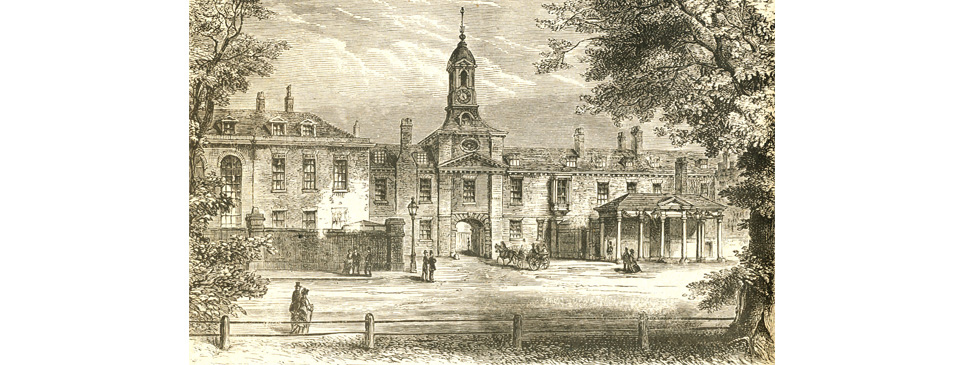Kensington Palace and Gardens

The West Front of Kensington Palace. It is separated from the adjacent street of Kensington Palace Gardens by Palace Green. Kensington Palace Gardens is now perhaps the most exclusive address in London, with houses selling for tens of millions of pounds. It was laid out in the 1840s over what was previously the kitchen gardens of the palace.
For over 70 years Kensington Palace was the London residence of successive kings and queens, from William and Mary until George II. It has continued to be the London home of many members of the royal family until today. It was where Diana, Princess of Wales lived, and where thousands of people came to lay flowers and other marks of sympathy following her death.
William III and his wife Mary jointly gained the throne when James II was overthrown in the Glorious Revolution of 1688. After 1512, when a fire destroyed part of Westminster Palace, the Royal Court had been based at Whitehall. William suffered from asthma, however, so he looked for a new residence away from the damp air of the Thames-side location at Whitehall. He considered Holland House, previously known as Cope Castle, at Kensington. William and Mary stayed there for several weeks in 1689.
A short distance away from Holland House, on the west of Hyde Park, was the suburban villa of Nottingham House with 26 acres of grounds. It had been built as a two-storey mansion in 1605 and from 1619 was in the ownership of the 1st Earl of Nottingham. It was inherited by his son, the 2nd Earl, who by 1689 was Secretary of State for the Northern Office (the foreign office minister for Northern Europe). Kensington was then a small village, quite remote from London. Nottingham House was more conveniently closer to the government ministers at Westminster and Whitehall than Holland House so that summer William and Mary agreed to buy it for £18,000 as their new permanent home. It was re-named Kensington Palace. The dryness of the air from the nearby gravel-pits was ideal for the asthmatic King.
From then until 1727 Kensington Palace grew to become an important royal residence. Furthermore, it attracted members of the royal court to the surrounding area, making the village of Kensington a highly desirable and fashionable neighbourhood.
In February 1691 the diarist John Evelyn wrote:
I went to Kensington, which King William has bought of Lord Nottingham, and altered, but was yet a patched-up building, but with gardens, however, it is a very neat villa.
Mary enthusiastically took charge of transforming the house and gardens. Sir Christopher Wren, Surveyor of the King’s Works, was instructed to enlarge the building. He added new wings, an additional floor, and re-orientated the building to face west, with £60,000 spent in the first year. A series of grand State Apartments were added, as were a chapel, accommodation for courtiers, kitchens, and stables. The work included the construction of a barracks building at the front of the palace, on Palace Green to the west of the main building. It was used to house soldiers who guarded the palace and survived until 1845.
Mary pressured the workmen to finish but with consequences. During one of her site visits a wall collapsed. A workman was killed and others injured, which gave her a tremendous shock. “I was truly humbled” she wrote to William. Progress was also delayed when a fire broke out, destroying a whole wing.
Work had progressed sufficiently that William and Mary could move into the unfinished Kensington Palace on Christmas Eve 1689. The King and Queen used the impressive palace halls to hold Drawing Rooms once or twice each week for distinguished guests such as ambassadors and foreign princes, as well as magnificent all-night balls for a thousand guests.
George London and Henry Wise from Brompton Nurseries were appointed to create formal gardens in the Dutch style to the south of the palace, with straight cut solitary lawns, gravelled walks, and flower beds at right-angles. Clipped hedges represented fortifications.
To keep royal messengers in contact with Westminster and Whitehall a road was laid out across the gardens, continuing through Hyde Park, Green Park and St. James’s Park. In winter the highway was illuminated with 300 lanterns to protect against highwaymen who lurked in Hyde Park, the first artificially-lit road in England. The track was named Route du Roi (King’s Road) but became anglicized to the current name of Rotten Row. (As late as 1749 the MP Horace Walpole was robbed by the highwayman James MacLaine in Rotten Row).
Mary was a keen collector of oriental porcelain and built an impressive collection, some of which remain within the palace. Work on the building was mostly complete in 1692 but just two years later she died of smallpox in her bedchamber in the palace. William lost his enthusiasm for lavish events. Nevertheless, after Mary’s death a section was created overlooking the south that housed a picture gallery, with private apartments below.
Peter the Great, Tsar of Russia, visited London in January 1698 to study Britain’s ship-building expertise. During his visit he regularly dined with William at the palace. Peter took little interest in William’s picture collection but was fascinated by his wind-dial. By February William was beginning to enquire as to when Peter might be departing after previous hints had been ignored. The Tsar finally left in April, having trashed his accommodation at John Evelyn’s property at Deptford.


